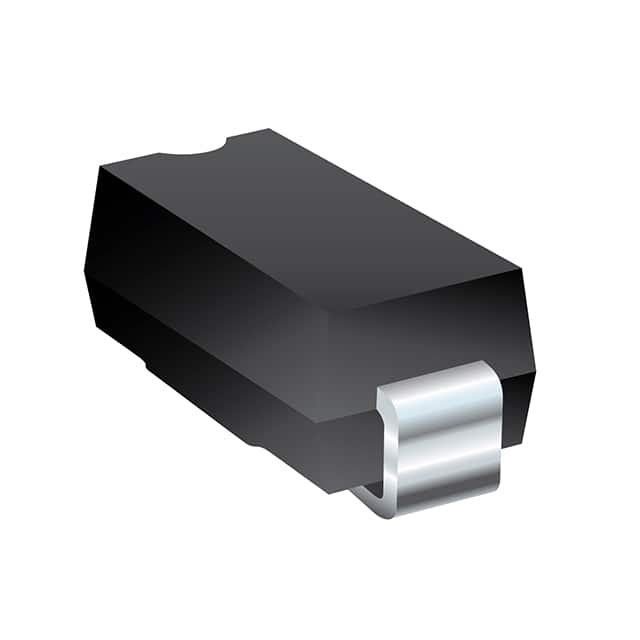SMLJ30A Diode: Encyclopedia Entry
Introduction
The SMLJ30A diode is a crucial component in the field of electronics and electrical engineering. This encyclopedia entry provides an in-depth overview of the SMLJ30A diode, including its product details, specifications, pin configuration, functional features, advantages, disadvantages, working principles, application field plans, and alternative models.
Product Overview
Category
The SMLJ30A diode belongs to the category of transient voltage suppressor (TVS) diodes.
Use
It is primarily used for surge protection in electronic circuits and systems.
Characteristics
- Fast response time
- High surge capability
- Low clamping voltage
Package
The SMLJ30A diode is typically available in a DO-214AB package.
Essence
This diode serves as a protective device against voltage transients and surges.
Packaging/Quantity
It is commonly packaged in reels or tubes, with quantities varying based on manufacturer specifications.
Specifications
- Peak Pulse Power: 3000W
- Breakdown Voltage: 33.3V
- Maximum Clamping Voltage: 53.9V
- Operating Temperature Range: -55°C to 150°C
Detailed Pin Configuration
The SMLJ30A diode has a standard DO-214AB package with two pins. The pin configuration is as follows: - Pin 1: Anode - Pin 2: Cathode
Functional Features
- Rapid response to transient overvoltage conditions
- Low leakage current
- Robust construction for reliability
Advantages
- Effective protection against voltage spikes
- Fast reaction time to transient events
- Wide operating temperature range
Disadvantages
- Limited power dissipation capability
- Higher cost compared to standard diodes
Working Principles
The SMLJ30A diode operates by diverting excess transient voltage away from sensitive components in a circuit, thereby protecting them from damage. When a surge occurs, the diode rapidly conducts, providing a low-resistance path for the excess energy to be safely dissipated.
Detailed Application Field Plans
The SMLJ30A diode finds extensive use in various applications, including: - Power supply units - Telecommunication equipment - Automotive electronics - Industrial control systems - Consumer electronics
Detailed and Complete Alternative Models
Several alternative models to the SMLJ30A diode include: - P6KE33CA - 1.5SMC33CA - SMAJ33A - SMBJ33A
In conclusion, the SMLJ30A diode plays a critical role in safeguarding electronic systems from voltage transients and surges. Its fast response time, high surge capability, and low clamping voltage make it a valuable component in diverse applications within the electronics industry.
Word Count: 410
Lista 10 Vanliga frågor och svar relaterade till tillämpningen av SMLJ30A i tekniska lösningar
What is the maximum forward current rating of SMLJ30A?
- The maximum forward current rating of SMLJ30A is 30A.
What is the peak pulse power dissipation of SMLJ30A?
- The peak pulse power dissipation of SMLJ30A is 3000W for a 10/1000μs waveform.
What is the breakdown voltage of SMLJ30A?
- The breakdown voltage of SMLJ30A is 30V.
Can SMLJ30A be used for surge protection in power supplies?
- Yes, SMLJ30A can be used for surge protection in power supplies due to its high surge capability.
What is the typical clamping voltage of SMLJ30A?
- The typical clamping voltage of SMLJ30A is 38.6V at 100A.
Is SMLJ30A suitable for overvoltage protection in automotive electronics?
- Yes, SMLJ30A is suitable for overvoltage protection in automotive electronics due to its fast response time and high surge capability.
What is the operating temperature range of SMLJ30A?
- The operating temperature range of SMLJ30A is -55°C to +150°C.
Can SMLJ30A be used for transient voltage suppression in telecommunication equipment?
- Yes, SMLJ30A can be used for transient voltage suppression in telecommunication equipment to protect against voltage transients and surges.
What is the reverse stand-off voltage of SMLJ30A?
- The reverse stand-off voltage of SMLJ30A is 30V.
Does SMLJ30A comply with RoHS requirements?
- Yes, SMLJ30A is compliant with RoHS (Restriction of Hazardous Substances) requirements, making it suitable for use in environmentally sensitive applications.


